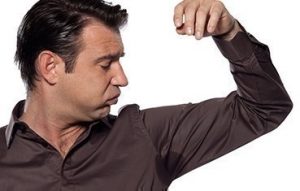Hyperhidrosis

Primary focal hyperhidrosis: This type of hyperhidrosis affects one or a few areas of the body, like the underarms.
Hyperhidrosis: Signs and symptoms
If you have this medical condition, you may notice:
-
- Visible sweating: When you are not exerting yourself, do you often see beads of sweat on your skin or have sweat-soaked clothing? Do you sweat when you’re sitting?
- Sweating interferes with everyday activities: Does sweating cause difficulty holding a pen, walking, or turning a doorknob? Does sweat drip heavily on to your papers or computer?
- Skin turns soft, white, and peels in certain areas: Does your skin stay wet for long periods?
- Skin infections: Do you get frequent skin infections on the parts of your body that sweat heavily? Athlete’s foot and jock itch are common skin infections.
Two types of hyperhidrosis
Both types cause excessive sweating, but there are some differences.
-
- In one or a few areas of the body: “Focal” means that the excessive sweating (hyperhidrosis) affects one or a few parts of the body. The areas of the body most commonly affected are the underarms, hands and/or feet, and forehead.
- On both sides of the body: If the excessive sweating occurs in the underarms, the person usually notices both underarms sweat excessively. The same holds true for the hands and feet.
- After waking up: Sweating may begin soon after the person wakes up, but the person usually does not notice damp sheets or wet clothing unless the room is hot.
- At least once a week: For many people, it occurs much more often.
- This type of hyperhidrosis usually begins when the person is a child or adolescent. Most people who have this type are otherwise healthy. In medical terminology, the word “primary” means that the cause is not another medical condition.
Secondary hyperhidrosis
In medical terminology, “secondary” means that the excessive sweating (hyperhidrosis) has an underlying cause. The cause could be a:
- Medical condition
- Side effect of taking a medicine or food supplement
Medical conditions that can cause excessive sweating include:
- Diabetes
- Frostbite
- Gout
- Injury, such as head trauma caused by an accident
- Menopause
- Obesity
- Overactive thyroid (hyperthyroidism)
- Tumor
If a person has this type of hyperhidrosis, the person may notice:
- The entire body sweats excessively: Sometimes, only parts of the body sweat.
- Sweating occurs during sleeping: If you sweat excessively while asleep, it is important to see a dermatologist to learn why this happens.
This type of sweating usually begins when the person is an adult. It also may begin after an accident or frostbite. Many medicines also can cause this type of hyperhidrosis.
Anxiety and embarrassment
Both types of hyperhidrosis can cause people to feel extremely anxious and embarrassed. Students often avoid raising their hand during class. Many teens never date. Adults may hide the sweat stains by wearing layers of clothing or changing frequently throughout the day.
References:
Bellet J. “Hyperhidrosis and hypertrichosis in children and adolescents.” Focus session presented at the 2013 Annual Meeting of the American Academy of Dermatology: Miami. Mar 2013.
Walling H. “Primary hyperhidrosis increases the risk of cutaneous infection: A case-control study of 387 patients.” J Am Acad Dermatol.2009;61:242-6.
© 2025 American Academy of Dermatology. All rights reserved. Reproduction or republication strictly prohibited without prior written permission. Use of these materials is subject to the legal notice and terms of use located at https://www.aad.org/about/legal
